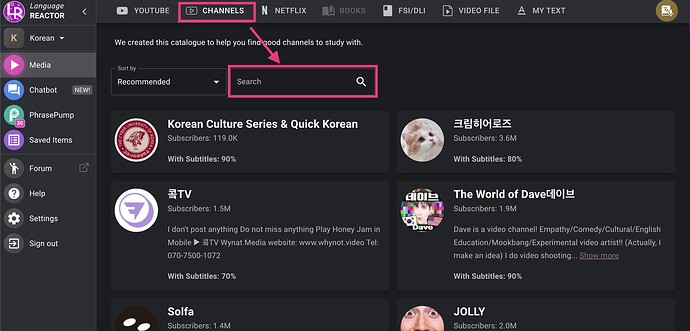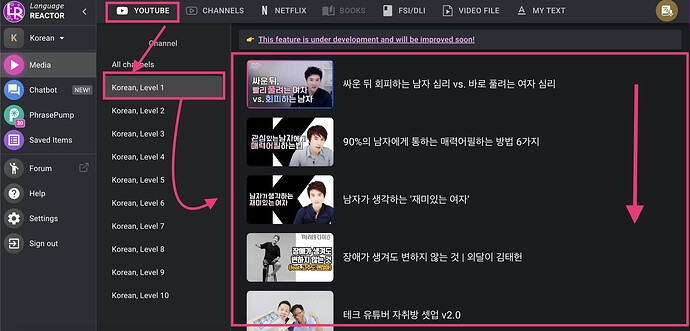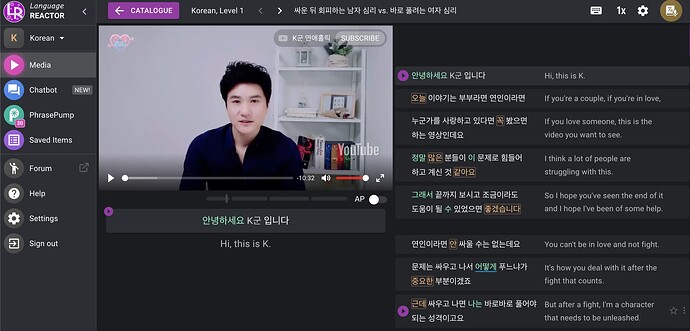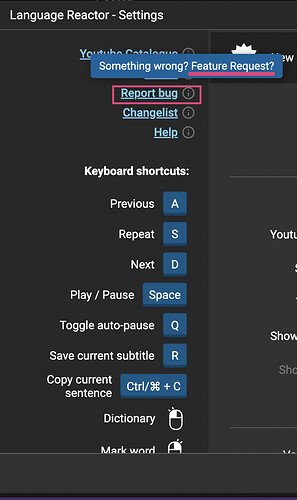Hi, when viewing the youtube videos in the LR webpage (Media > Youtube), how can I search them? I am only given an option on the left to choose a level of my language and then all videos are listed randomly. Is there some way to categorize them by topic? And Why are these videos shown here? Why not just send us to youtube? Are they curated?
Thanks
Hi @Max_Marko,
This section will allow you to search by channel, then send you to Youtube where you can search the channel’s videos on your own.
This section just allows you to view content that may be more accessible to language learners of a certain level. And it allows you to interact with duel subtitles through LR’s website rather than just via Youtube with the LR extension (handy for mobile devices via its browser):
These features are currently being worked on:
Linked URL: What stuffs are David and Ognjen doing? ==> Megacatalogue
If you have any organization ideas, I recommend sharing them through 1 of 3 (or all of these 3 methods):
- Drop it into the Request category
- Email them: languagelearningextension [at] gmail [dot] com
(Replace bracketed text with their corresponding characters and remove extra spaces.)
- Or suggest a feature the but through their extension in the settings gear (
 ) by selecting “Feature Request” after “Report bug”:
) by selecting “Feature Request” after “Report bug”:
Additionally, if you are looking for other methods of searching for content based on topic or something, this might help:
https://filmot.com/captionLanguageSearch
Using this site, you can search for videos — based on topic — with subtitles in 1 or multiple languages and with manual subtitles (human subs/CCs) — or — auto-generated subtitles:
It’s not comprehensive, but they’re slowly expanding their catalog.
They also have a Patreon for users who want to support their project or would like to prioritize indexing their favorite channels or adding new features.
I hope this helps! 
2 Likes
Thanks for your answer. Yes, the youtube section needs work. Filmot looks very interesting though.
Can you tell me what the difference between “human” and “machine” translations are besides the obvious. Did someone actually sit down and manually translate the “human” translations for LR?
2 Likes
Hi @Max_Marko,
LR doesn’t create translations exactly.
For human translations, LR takes the subtitles that it finds in the video source — for YouTube it’s the translations that the YouTuber uploads with their video, for Netflix it’s the translations that Netflix paid translators to do for videos.
For human translations, a human did theoretically sit down and caption/subtitle the captions/subtitles — for the Netflix/YouTube video — not LR.
If you ever have a problem with wrong human translations (i.e. mistranslations) it’s a mistake on YouTube/Netflix’s part, not LR’s as they just scrape the data they find from the source for those subs/captions.
For machine translations LR does translate those themselves — using Microsoft translate, I believe. It means an AI of some sort translated the target language subtitles into whatever you selected as your translation language.
These types of translations result in more direct and less contextually-based translations — especially if the translation software used is not trained/advanced enough in the language it is pulling data from to translate.
I find that for contextual languages like Korean, these translations from LR tend to be not so good, so I avoid using these if I can — especially as a beginner.
I’ve had more success using DeepL and translators like Papago to do my machine translations outside of LR for languages like Korean — a.k.a. third party translation services designed for/highly trained on the target language I’m learning, which is just Korean right now.
I hope this explanation helps!
Note: for the human translations, if LR shouldn’t count auto-generated subs from YouTube as “human translations”.
2 Likes





